Protecting your joints when you're gardening
Gardening can be great for your physical and mental health. However, some heavy and repetitive tasks in the garden can be difficult if you have arthritis.
Little and often is usually the best approach and switching between different jobs will give your joints a rest. Good protective clothing, such as gloves, and hand and wrist splints can help protect your joints. Using lightweight equipment can make things a lot easier.
Change tasks to reduce the strain
Don't be tempted to press on until the job is finished. Try switching tasks after 20 minutes, or after a shorter time if you need to. Have a rest if you need it, and then switch to a task that uses different joints. For example, break up harder jobs like hoeing weeds with something gentler like deadheading or pricking out seedlings. You could set a reminder on your phone, if you think it would be useful.
Spread the load
Try to spread the weight of items when you carry them by resting them on your forearms and hands, rather than trying to pick them up with your fingers only. Try resting a tray of seedlings on your forearms, for example. Keep your elbows tucked in to reduce the strain on your shoulders and elbows.
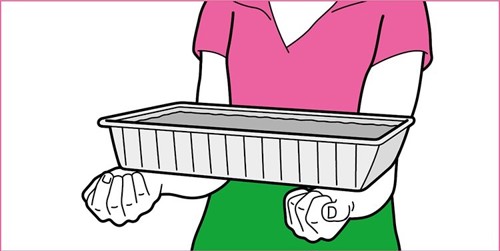
Use a garden stool
This will save you energy and reduce the load on weight-bearing joints. It might limit your reach, so you will need to plan your borders around this, or you could buy lightweight, long-reach or extendable handled tools. For other tasks, sitting could allow you to use shorter, and therefore lighter tools. Make sure you can get up easily from the stool - avoid sitting for too long and getting stiff as this will make rising more difficult. Some garden stools reverse to form seats with handles.
Get a good grip
Slip a spongy rubber sleeve over the handle of a hoe or rake to increase grip. This will reduce the strain on your knuckles and jarring of the joints.
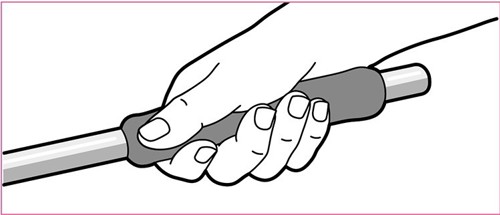
A good pair of gloves will also help you grip more easily. If you find it difficult to find gloves to fit – for example, if your arthritis has changed the shape of your hand – think about trying gloves made from elasticated material that fits on the hand and can then be strapped using Velcro. Alternatively, gloves that don't have the full finger length but which have flexible material may be useful.
Wear splints
An occupational therapist can advise on whether splints might support the joints of your hands and wrists to reduce the strain of some tasks.
A wrist splint may be helpful if you have painful or weak wrists, while a thumb splint may be useful for tasks that need a firm grip, for example pruning. Wearing gardening gloves, or gloves with rubber on the palm and fingertips, over splints will keep them clean, and increase your grip.
Plan ahead to avoid unnecessary effort
If walking is difficult, avoid too many journeys up and down the garden by taking all the things you need in a wheelbarrow, bucket or trug. This will cause less strain on your hands, wrists, elbows and shoulders. Try not to start too many things that must be attended to whether you feel like it or not, and don't worry too much about weeds and not getting all your jobs done – they can always wait for another day.
Seek help with heavier jobs
Decide beforehand what you need help with and what you prefer to do yourself. Make sure that a well-meaning and enthusiastic helper doesn't take on more than you really want them to.
If it suits you, could you afford to pay for professional help either on a regular basis or every now and then? You could ask them to do jobs you struggle with allowing you to continue with tasks you enjoy and don’t find difficult.
If you can't get help lifting bags of compost, especially from the boot of a car, think about buying two or more small bags instead of one large one. Many manufacturers now include handles on their compost bags, which makes them much easier to carry. Another option is to find expandable compost that's dehydrated and much lighter.
Some garden centres deliver items such as compost, sand or gravel, and put them in your shed or garage.
Using the right equipment
Investing in some good, lightweight tools can make a big difference.
Gripping and squeezing pruning tools over a length of time can hurt finger joints. Try to use tools with padded handles, and have regular breaks or do other jobs in between. The following tools may make things a little easier:
A ratchet pruner takes less effort to cut through twigs than most secateurs. Instead of one big squeeze it takes several bites to make the cut, reducing strain on your knuckles.
A two-handed lopper will give good leverage without much effort and can be held lightly against your palms and wrists, protecting your finger joints from strain. Some manufacturers also produce 'ratchet loppers' – these have a mechanism which will hold the blades in place if you need to stop mid-cut.
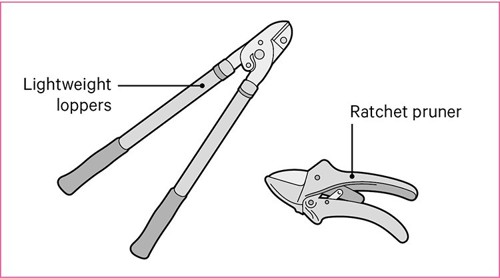
Pruners, loppers and secateurs with a cut-and-hold action hold the cut stem in their jaws so it doesn’t fall to the ground, which saves you bending to pick up the cuttings.
English trimming shears can be used for light trimming after the flowering of heathers and lavender. You don't need to move your fingers much to squeeze the blades together, and you can use them one-handed.
A border spade is lighter and easier to handle than a digging spade. See the section on 'Preparing the soil' for more information on how to make digging easier.
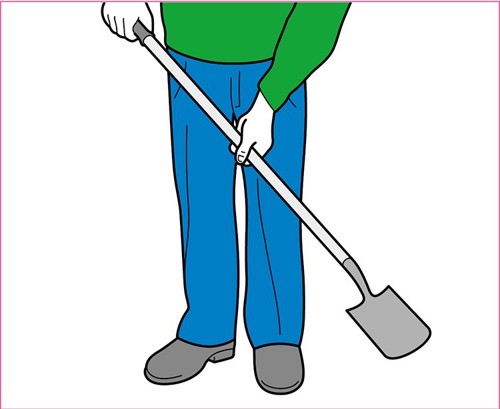
If you're looking for lightweight gardening equipment specially designed for people with arthritis, you might find something that suits your needs on the Arthr website.
Arthr is a social venture powered by Versus Arthritis. Arthr's products are co-created and tested with people who have a first-hand understanding of the day-to-day challenges of living with arthritis. All profits are invested back into developing better products for people with arthritis and into services, support and research of Versus Arthritis.
Low-maintenance gardens
Planning your garden and choosing low-maintenance plants will make things easier if you go on holiday or into hospital, or if you don’t feel up to gardening for a while.
Lawns need mowing regularly throughout the summer, so if you're often away from home and don't have reliable help it may be worth replacing the lawn with a low-maintenance area such as paving or gravel. Many artificial grasses are now available as an alternative to a lawn. Growing in raised beds, planters and containers are other ways to enjoy plants when you have removed lawns and borders.
Plants like elephant’s ears, cranesbill, lavender and periwinkle backed by shrubs such as barberry, escallonia, senecio and viburnum can take care of themselves for long periods once their roots are deep in the soil.
Create a wildlife area using wildflower seeds, which don’t usually need tending, although you’ll need to prepare the ground well beforehand to avoid getting more weeds than flowers. This is also good for encouraging wildlife into the garden.
There are a number of books and websites on low-maintenance gardening which will suggest plants that don’t need a great deal of attention.
Visit the Royal Horticultural Society's website and search low maintenance gardens, for more information.
Garden layout
Working in the garden can be much easier if you give some thought to its layout. You may need to get some help initially to make changes to your garden, but in the longer term this should allow you to manage most of your gardening jobs yourself.
Paths and beds
Ideally there should be firm paths alongside the beds and borders, especially if you have difficulty keeping your balance on uneven ground. You can then tend to most of the area without having to step onto the soil. The beds should be quite narrow so you can reach the middle and back without stretching.
Non-slip paving slabs, and compressed gravel, make safe paths. Cut slabs can be used for shallow steps where the ground level changes. Wooden handrails alongside steps are also helpful.
If you find it difficult to bend to ground level or need to work from a wheelchair, a raised bed would be helpful. If you have a sloping garden, you can make a terrace by building a low wall and filling behind with soil, which has the effect of making a raised bed. Even raising the soil level a small amount will make the bed easier to manage.
Containers
Containers are another way of making sure you can work at a convenient height. Annual bedding plants, heathers, herbs, spring bulbs and even smaller vegetables and fruit trees can be grown in this way. Heavy tubs can be put on wheels in case you need to move them around. Wheeled containers with a braking system are also available – these may be easier to manage, but they’re more expensive. You could raise containers on bricks, or on top of other upturned heavier containers.
Herbaceous borders
The word herbaceous means plants that don't have woody stems above the ground. They can be perennials, which means they last for more than two years, or the more short-lived annuals and biennials.
Traditional herbaceous borders need a lot of attention – staking, pruning, dividing, dead-heading and weeding. You can reduce the need for staking taller plants by choosing self-supporting varieties, for instance lupins, phlox, yarrow and Japanese anemones.
If you can't reach the back of the border easily, it’s better to plant shrubs that need less attention. Spurge, spindle tree, spotted laurel, cinquefoil and Mexican orange blossom are good examples. Small annuals such as pansies and marigolds can be planted near the path, but an edging of pinks or lady's mantle will create less work.
Preparing the soil
Digging the soil
Improving the quality of your soil will make cultivation easier. Heavy clay can be made lighter by digging in manure or compost. Adding sharp sand or grit lets air into the soil, making it easier for roots to bed in. It also makes it easier to dig in the future. Turning the soil over in autumn exposes it to winter frosts and makes it easier to break down, ready for sowing the following season.
When you do need to dig, bear in mind the following:
- A border spade is lighter and easier to handle than a digging spade. The blade is smaller so you won’t be tempted to dig large spadefuls.
- Soil tends to cling to ordinary carbon steel spades, which adds weight, so stainless steel is a better choice. It’s also easier to clean afterwards.
- Spades with extra-long handles make it easier to move the soil and reduce the need to bend.
- If your soil is light and crumbly, use a border fork instead of a spade – it’s lighter and moves through the soil more easily.
- Clamping an extra handle part-way down the shaft of your spade or fork saves bending too far and provides a comfortable grip for your lower hand without twisting your wrist.
If the soil is light and sandy, you may not need to dig at all. A soil miller is a tool with star-shaped wheels that break down the soil into fine particles as you move it backwards and forwards.
Well-rotted manure spread over the surface can be incorporated into the soil with the soil miller. This is a good tool for use with a deep-bed system.
Weeding
You can reduce the number of weeds you have to deal with by covering the soil with a 5 cm (2 inch) layer of shredded bark. This stops the soil getting any light and makes it more difficult for weeds to grow. Alternatively, you can cover the bed with black polythene, cut slits into the sheet and plant seeds through the holes. Scatter a layer of gravel over the top to hold down the polythene and improve the border’s appearance.
Annual weeds should be hoed while they’re young and easy to deal with. We don’t recommend a draw hoe or a Dutch hoe because the blade has to be lifted and lowered over and over, which can strain your joints. A push-pull tool such as a soil miller, see image below, skims the soil surface back and forth, chopping off the weeds at ground level with little effort. You could fit an extra-long handle if you need to.
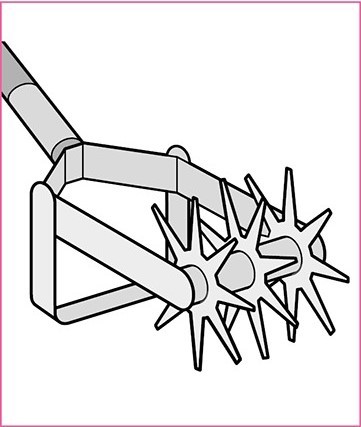
Weeding by hand is tiring if you can't easily reach down to ground level. You can try a weed puller instead. A weed puller has a steel blade that you push into the ground alongside the weed. Closing the handle grips the weed and pulls it out. Although this only deals with one weed at a time, it saves raking together and picking the weeds up afterwards. It’s also easy to use sitting down.
If you don't want to use a weed puller, you can collect small amounts of weeds and leaves in a bucket or bag. You can buy tools to help you pick up garden rubbish without bending.
The lawn
Some people increase the size of their lawn to reduce the area of cultivated borders. However, a lawn needs regular attention if it's to look its best. If you find it difficult to look after, it might be better to have narrow beds separated by paths or to pave or gravel the area, leaving spaces to plant shrubs or annuals.
Island beds in lawns make mowing more complicated. It’s easier to move the mower around if the lawn is a simple shape with straight edges. Make sure the mower is stored somewhere that you can access easily.
Mowing and clipping the lawn
Lightweight lawnmowers with easy-to-push buttons could be the best option if you have arthritis. Look for one with a single horizontal and large-grip handlebar, rather than two separate handles. This would let you do some of the pushing with your stomach to reduce strain on your arms and wrists.
Many electric models are fairly light. Cordless battery-operated mowers are also available. These can be easier to move around as you don’t have to keep moving a cable, but some models do have heavy batteries. Petrol-engine mowers are often heavy to move and manage.
If you have a large garden, a ride-on mower might be an option. Robotic mowers have improved in recent years and although expensive they do get good reviews.
You don’t have to collect grass cuttings – in dry weather especially it’s better to leave them on the lawn – so you can reduce the weight you have to push by leaving off the grass box.
Lightweight edging shears with long handles that are generously padded will give a more comfortable grip and reduce jarring of the joints. Or you could use a nylon cord trimmer that operates vertically – you simply walk along holding it against the edge of the lawn.
Growing plants
Sowing seeds
If you have trouble bending down to ground level, you can buy tools to help with sowing seeds. The loaded tool is pushed along the drill, emptying seed as it goes along. You can also buy or make your own ‘seed tapes’, which are strips of soft paper with seeds attached at even spaces. You can lay these into a shallow trench and cover them over.
To sow peas or beans, you can sow drop them into the trench down a length of plastic pipe. Use a lightweight mini-rake to draw a shallow layer of soil over the trench to cover the seeds.
Planting out
Planting out summer bedding plants involves a lot of bending. You can avoid this by only growing shrubs and herbaceous perennials. Alternatively, you can dig a hole using a long-handled trowel, put the plant on the blade and lower it into the soil. You can do this sitting down if it’s easier. Pot-grown plants are the most suitable for this method.
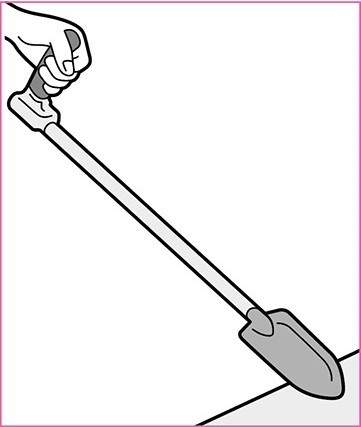
Watering the plants
It’s useful to have a mains water supply at a central point of the garden so that you can water any part using a short hose or sprinkler. If this isn’t possible, attach a short hose to on outside tap if you have one, or place water butts where you need them most. You can fill them from time to time with a hose if you need to, and dip a small watering can into the tanks when you need to water the plants. Use both hands to spread the weight when you use a watering can.
If you have free-draining borders that are in full sun, it’s best to use them for growing drought-resistant plants such as wallflowers, rosemary, broom and cotton lavender, which come to no harm if they dry out for a few days. This will help reduce the amount of watering you need to do.
Mulching with shredded bark reduces water loss, but the mulch should only be put in damp soil. Hanging-baskets keep their moisture longer in light shade, and plants like fuchsias, ivy-leafed geraniums, lobelias and Busy Lizzies grow well in these conditions.
A hanging-basket sprayer is useful for watering a basket that’s too high to reach with a watering can. You can buy special hanging-basket compost with crystals that help keep moisture in so you don’t have to water so often. Crystals are also available for mixing in with standard compost.
Growing fruit and vegetables
Fruit
You can buy fruit trees that have been grafted onto dwarfing rootstocks. This restricts their growth, making the fruit easy to reach. You can grow fruit trees as cordons in a slanting row, or espaliers and fans, perhaps against a wall or fence. You can restrict their height to whatever suits you by pruning in August.
Gooseberry plants can be grown on a leg – a single clear stem 60–90 cm (2–3 feet) high. This saves you bending down to pick them. Strawberries are easier to gather if they’re grown through holes in a barrel or in hanging baskets.
Vegetables
If you want to grow tomatoes and courgettes outside but your soil isn’t good enough, you can use growbags. Growbags that have been used for growing tomatoes and cucumbers in the greenhouse can be recycled the following year for salad crops such as lettuce, radishes, spring onions and beetroot.
You can place the bags on a bench if it's easier to reach them. Many fruit and vegetables can also be grown in hanging baskets or raised containers, which can make them easier to tend and harvest.
The deep-bed and no-dig method
A labour-saving way of growing vegetables is the deep-bed method. You may need help with digging the plot to start with, but then no further digging is needed for several years. Divide the plot into strips 1.2 m (4 feet) wide, separated by paved paths. Dig the ground over well, adding compost or alternatives into each trench. Don’t walk over the soil after this stage. All cultivation, planting, weeding, feeding and harvesting is done from the paths using long-handled tools.
Because the soil isn’t compacted, sowings of root crops can be spread more densely than normal over the whole surface – the growing plants push each other sideways in the easily crumbled soil. You don’t need to sow in rows, and planting many seeds will make it harder for weeds to grow.
You’ll need to lay a fresh supply of compost or mulch on the surface during the following autumn. This will work down into the soil by the action of worms and by weathering during the winter. A little light cultivation in the spring will make sure it’s completely mixed in.
There is a school of thought that a no-dig approach is better for the environment, as well as saving you heavy work. If you search for ‘no-dig’ on the internet you will find plenty of good advice, such as at Garden Organic.
Garden buildings and furniture
If you can, place garden buildings such as greenhouses, potting sheds, tool sheds and cold frames near each other. This will save you carrying pots, compost and seed trays too far.
The lids of some glazed cold frames are very heavy to lift. A raised frame with a hinged lid covered with lightweight corrugated plastic sheeting and connected to a pulley and counterbalance weight is much safer and easier to manage.
The greenhouse
The staging in a greenhouse should be at the right height. You should be able to work comfortably while sitting on a chair. You may prefer to rest your elbows and forearms on the staging while you work. If all the staging is at the same height, it’s easy to slide trays along without lifting them.
Thermostatically-controlled fan heaters, automatic vent openers and capillary watering systems go a long way to providing the right growing conditions with minimum effort. By using growbags for tomatoes and cucumbers you can even avoid digging the border soil.
Garden seating
Garden seating shouldn’t be too low and should have a supportive backrest. If you’re thinking of buying some new garden seating, it’s worth trying before you buy to make sure it’s a comfortable height and has the right support for your back.
Having seating in your garden will encourage you to pace yourself and take frequent breaks, especially if it’s placed in the areas you work in most. It’ll also give you somewhere to admire and enjoy your work from. Using fold away lightweight chairs can be useful as these can be kept in a shed or garage whilst not in use.
Hedges and fences
Even slow-growing hedges like yew need trimming once a year, but hand shears can cause joint pain and some hedge trimmers are quite heavy. Keep your hedges low so you don’t need to stretch too much.
Lavender and box make good low hedges for dividing up the garden. A row of fruit trees grown as cordons makes a decorative hedge, perhaps to separate an ornamental garden from the vegetable plot.
A wooden fence that’s been put up properly and treated with preservative will last for many years without attention and can be used as a support for climbing plants. Plastic fencing is also available and should need even less attention. If your garden is in a windy location look for windproof fencing options.
What if I don't have a garden?
If you don’t have a garden, is there a chance for you to have a mini-garden in your home or on a balcony? This could be a tray of plants, fruits or vegetables.
Does a friend or relative have a garden or allotment you could help with?
In some parts of the country you might be able to rent an allotment plot.
The National Allotment Society has information about how allotment plots can be rented and advice on how to get an allotment.
Penny's story
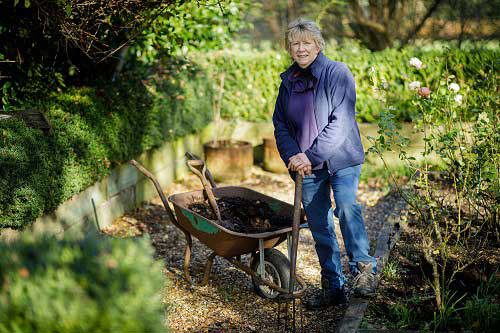
Penny has osteoarthritis in both hands, especially her thumbs.
"I became a self-employed gardener in April 2013. I look after 20 to 25 gardens on a weekly or fortnightly basis.
I do general gardening, weeding, tidying, pruning, planting, and help people come up with ideas.
The thumbs have become a bit of an issue. But I am determined not to let arthritis stop me gardening.
I want to carry on for the customers I serve, a lot of whom are over 80. Gardening can create a great sense of pride and satisfaction, as you see the garden grow and bloom.
I've seen a hand specialist who taught me how to carry on for as long as I can by swapping between tasks to minimise the pressure on my hand joints.
I don't do heavy landscaping. I've got a little network of people who can do the jobs I can't. I have a friend who has a ride on lawnmower and does the lawns of the big gardens. And there is someone who can do the high up pruning.
Gardens are so important as they get people outside. Some people I work with have arthritis or osteoporosis.
There is someone with arthritis who has a seat, and she will sit and do her work while I’m there. She likes the social side of it.
I have a customer who is 87. He’s an ex rugby player, and likes to do his mowing. He does that and I do the bits he can't.
It's annoying and frustrating at times to know you can’t do as much as you used to. But, you have to think ahead with arthritis. It's so easy to get carried away and you might get distracted and do too much.
It's not a weakness, it's just accepting the situation and working with it and working around it.
I mix the jobs up and make sure I am not doing the repetitive tasks for too long. You could take a mobile phone out with you and put an alarm on so that you're not doing the same thing for too long, or if you have an outdoor clock keep an eye on that.
As well as mixing up tasks, and pacing through the day, I pace through the week and have rest days.
I know that if I do too much one day, that is potentially it for the next four to five days.
You might not be able to do all aspects of gardening or do it as aggressively as you used to. You might need to get someone in to help. Don't be afraid to ask for help.
Being outside in the fresh air, seeing something come into flower is amazing. There is nothing better than working outside and seeing a little robin land on your spade."
Or when there is frost or snow and you see snow drops peak through; that is joy and hope. Whatever else is going on, gardens show that life still carries on and you can still carry on."
Where to turn to for more support
If you're struggling with aspects of gardening, an occupational therapist could help. These are trained healthcare professionals who can help you find different ways to do everyday tasks that arthritis is making difficult.
You can search for an occupational therapist near you on the The Royal College of Occupational Therapists website.
The charity Thrive provides support and services to allow people with a range of conditions to continue to enjoy gardening and its physical and mental health benefits.
Trellis is a charity that promotes gardening as a way to improve health and wellbeing.